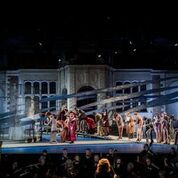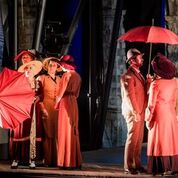Donizeti: Rosmonda d’Inghilterra
Donizetti Opera, Sebastiano Rolli
DYNAMIC 37757
This is a revised edition of the score based on primary sources, of a work which has five substantial solo parts which require technical finesse as well as stamina. The story is loosely based on Henry II and Eleanor of Aquitaine, and his affair with Rosmonda. After what appears to be a fairly conventional approach to the narrative it has a totally unexpected ending. Leonora (Eleanor) stabs Rosmonda to death and the chorus say Oh Dear –just that; no final chorus, no lingering death aria. Just Oh Dear and down curtain. It is a real shock even today and must have been outrageous at the time. It may also account for the lack of enthusiasm for the work which, from all other points of view, is finely structured and gives the soloists a lot to do.
The two women – Jessica Pratt as Rosmonda and Eva Mei as Leonora – are splendid, though the two male protagonist are certainly powerful in approach. Sebastiano Rolli conducts from memory and brings spirited accompaniment from the pit. The production is often couched in stygian darkness and the chorus seem as lost as the audience as to what they are supposed to be doing. However, this should not put you off as the work has real merits.
Faure; Music for Cello and Piano
Andreas Brantelid, cello; Bengt Forsberg, piano
BIS 2220
This cd mixes the familiar with the lesser known to good effect. All of the eleven pieces have real worth, and include the Sonata No2 and the original arrangement of the Romance for cello and harmonium. An engaging disc.
Tchaikovsky: The Sleeping Beauty; The Nutcracker; Swan Lake
Bergen Philharmonic Orchestra, Neeme Jarvi
CHANDOS CHSA 5204(5)
These recordings were issued separately but are very welcome as a complete set. Not only are the scores complete in themselves but Neeme Jarvi brings an entirely orchestral approach to them so that we hear concert music rather than ballet scores. While I expect some might find the tempi somewhat difficult to accept in terms of the dance, it makes for very exciting listening.
Busoni: Orchestral works
BBC Philharmonic Orchestra, Neeme Jarvi
CHANDOS CHAN 241-57
This is a reissue of recordings made in 2002 and 2005. Though Busoni’s orchestral works are not very familiar this dual set makes a good case for their inclusion in more orchestral programmes, particularly the shorter pieces which would sit well as openers. John Bradbury also makes a good case for the Clarinet Concerto of 1918.
Verdi: Don Carlo
Teatro Regio di Parma, Daniel Oren
DYNAMIC 37776
This recording was made in October 2016, the production directed by Cesare Lievi. It is remarkably straight-forward – not to say traditional – in its use of sets and costumes and will therefore appeal to those who like to simply be able to relax and enjoy the drama as it unfolds, without having to worry about why the cast are doing strange things. It is equally well sung throughout and Daniel Oren in the pit holds his forces together with skill.
Bruckner: Symphony No 3
Staatskapelle Dresden, Christian Thielemann
UNITEL 740808
This series is proving to be very impressive and is maintaining its impact as Christian Thielemann moves back to the Third Symphony. With glowing wind and mastery of long, unfolding passages may I respectfully suggest you listen to this with the volume turned up to the gain the impact you would in the concert hall. This is not a DVD for a portable system!
Mahler: Symphony No9
BR KLASSIK 900151
Beethoven: Symphony No9
BR KLASSIK 900156
Bayerischen Rundfunk, Mariss Jansons
These are both fine recordings and both come from live performances. The Mahler was recorded last October in Gasteig and the Beethoven is a reissue of a performance given in the Vatican in 2007. The Roman acoustic is quite resonant though it does not fudge the sound as much I had suspected it might. The Gasteig performance is alive with detail and Mariss Jansons’ familiar sensitivity to line. Both warmly recommended.
Haydn: Quartets Op 20 4-6
Chiaroscuro Quartet
BIS 2168
The Sun Quartets are among the most challenging to performers if not to listeners – who simply lap up their beauty. The notes give a detailed analysis of this complexity and take us through the deeply introspective nature of much of the writing. This is finely mirrored in the playing of the Chiaroscuro Quartet and make the recording well worth revisiting.
Brahms: Sonatas for cello & piano Opp 38 & 99
Schumann: Funf Stucke im Volkston
Robin Michael, cello; Daniel Tong, piano
RESONUS RES10188
I wish I could feel more enthusiastic about this recording. It is certainly well played and I enjoyed some of the Schumann pieces, but the Brahms seems to me to be worth but a little dull. A pity given the obvious delight the performers have in the scores.


